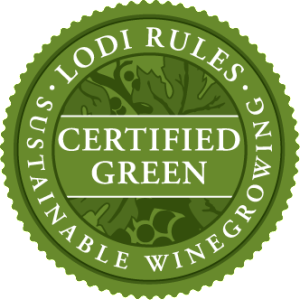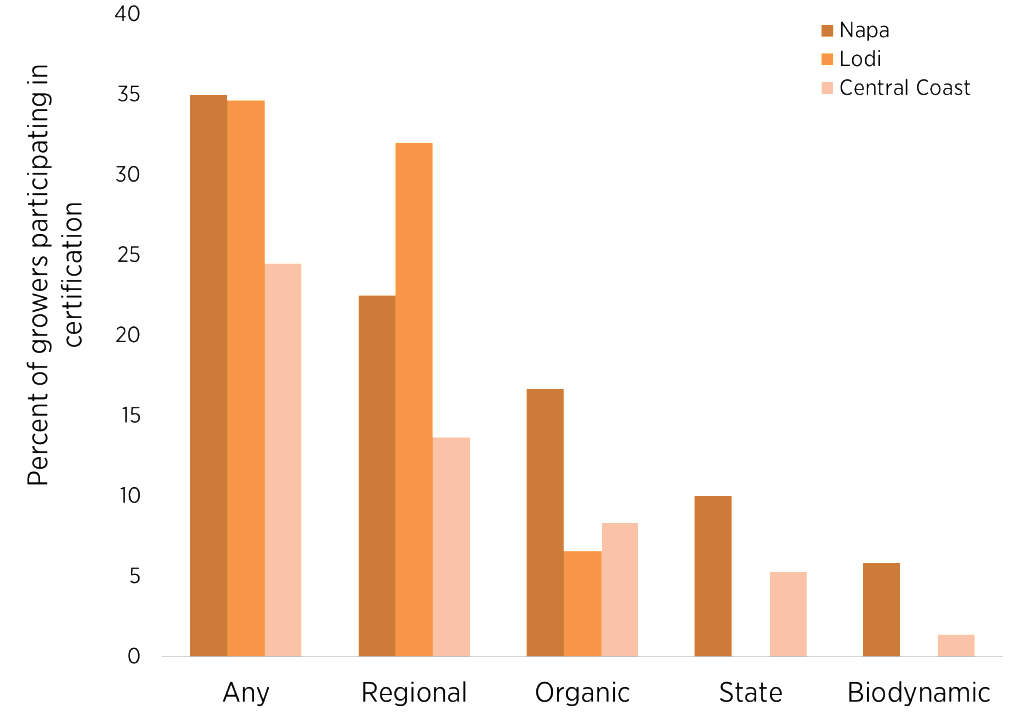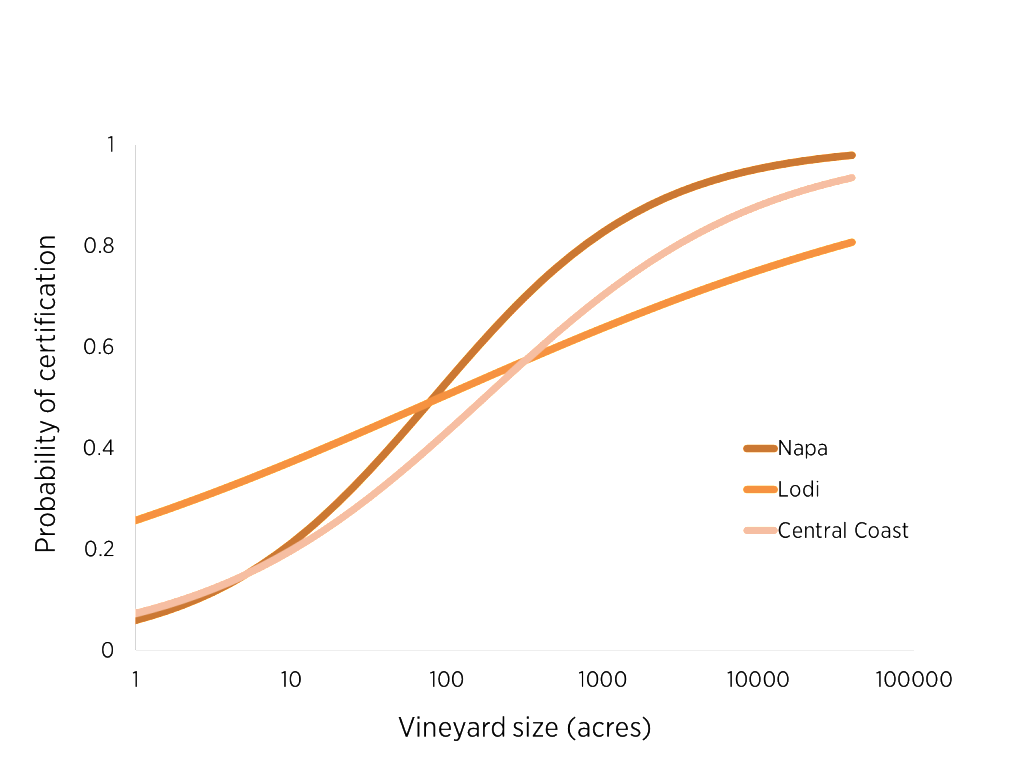![]() Sustainable winegrowing certification programs in California, and other major domestic winegrowing regions, have gained traction as a market tool to inform consumer choice and promote grower adoption of sustainable practices. Prominent examples of such programs include the Lodi Winegrape Commission’s Lodi Rules program, the Central Coast Vineyard Team’s Sustainability in Practice (SIP) program, the California Sustainable Winegrowing Aliance’s California Certified Sustainable Winegrowing program, and the Napa Green Land program. However, little research has been conducted that looks into why some growers decide to participate in certification programs while others do not. This study sought to identifying the factors that drive growers’ decision to participate in any one of California’s four sustainable winegrowing certification programs. Our results have implications for evolving the programs to more effectively realize their economic, environmental, and social goals as well as boosting grower participation.
Sustainable winegrowing certification programs in California, and other major domestic winegrowing regions, have gained traction as a market tool to inform consumer choice and promote grower adoption of sustainable practices. Prominent examples of such programs include the Lodi Winegrape Commission’s Lodi Rules program, the Central Coast Vineyard Team’s Sustainability in Practice (SIP) program, the California Sustainable Winegrowing Aliance’s California Certified Sustainable Winegrowing program, and the Napa Green Land program. However, little research has been conducted that looks into why some growers decide to participate in certification programs while others do not. This study sought to identifying the factors that drive growers’ decision to participate in any one of California’s four sustainable winegrowing certification programs. Our results have implications for evolving the programs to more effectively realize their economic, environmental, and social goals as well as boosting grower participation.
__________________________________________________________________________________
This Coffee Shop reports a few findings from a National Science Foundation study of winegrape grower participation in sustainability certification programs. More comprehensive results will be published here in the Coffee Shop and elsewhere soon. Stay tuned!
__________________________________________________________________________________
 This Coffee Shop article was written by Michael Levy, Matthew Hoffman PhD, Mark Lubell PhD, and Vicken Hillis PhD, and was originally published as a policy brief from the UC Davis Center for Environmental Policy and Behavior (CEPB). This report is part of a larger study looking at winegrape grower adoption of sustainability practices, participation of in outreach and education programs (including certification), and the way in which they access information about sustainable winegrowing. The study was funded by the National Science Foundation. We surveyed winegrape growers in three California American Viticultural Areas (AVA), the Central Coast, Lodi, and Napa Valley, about their practices and participation in certification programs. For more information about our other reports, contact Matthew Hoffman.
This Coffee Shop article was written by Michael Levy, Matthew Hoffman PhD, Mark Lubell PhD, and Vicken Hillis PhD, and was originally published as a policy brief from the UC Davis Center for Environmental Policy and Behavior (CEPB). This report is part of a larger study looking at winegrape grower adoption of sustainability practices, participation of in outreach and education programs (including certification), and the way in which they access information about sustainable winegrowing. The study was funded by the National Science Foundation. We surveyed winegrape growers in three California American Viticultural Areas (AVA), the Central Coast, Lodi, and Napa Valley, about their practices and participation in certification programs. For more information about our other reports, contact Matthew Hoffman.
Results
Participation in sustainability certification programs is widespread among growers (Figure 1) and is arguably a viable tool for improving economic, environmental, and social benefits of farming without imposing additional regulations on agriculture. Figure 1 shows the percent of all certified growers broken down by region and certification type. For example, from among the total number of growers participating in any certification program, about 7% are certified Organic in Lodi. Depending on the AVA, between a quarter and a third of growers are participating in some sustainable winegrowing certification program (indicated in Figure 1 as “Any”). This result demonstrates that the sustainable winerowing certification programs are well-established and play an important role as outreach tools for supporting grower adoption of sustainable practices. (See Hoffman 2013 for a report on practice adoption differences between growers participating and not participating in the Lodi Rules certification program.)
Figure 1 also shows that grower participation in the regionally focused programs (Lodi Rules, Napa Green, and SIP) is stronger than in the state-wide program (California Certified Sustainable Winegrowing). While USDA Organic certification had moderate participation, the percentage of participating growers is markedly less than the percentage participating in the sustainability programs. Finally, grower participation in Biodynamic certification trails well behind all other programs. These findings are not surprising if one considered the origin of the different programs. Both Organic and Biodynamic certification have their roots in agriculture more broadly, while sustainable winegrowing certification programs were developed specifically for California viticulture, and therefore are more relevant to the practical realities of winegrowing and are more in line with the needs and demands of the wine market. Furthermore, having their origins in the industry means that sustainable winegrowing programs have grower buy-in, which translates into greater support and participation. Wines made from Organic and Biodynimic certified grapes do capture niche markets, but the four sustainable winegrowing certification programs clearly dominate.
One of the most interesting findings from this study is that participation in sustainable winegrowing certification programs is much more common among larger growers (Figure 2). This result is evidence of both a success of these programs and a challenge to be addressed. When larger winegrape growers participate in certification programs, the economic, environmental, and social benefits of sustainability practices are being maximized through implementation over a large number of acres. The challenge is that the costs associated with certification are prohibitive to smaller growers, who are less likely to have the necessary economies of scale or capital resources. While large vineyards are more likely to participate in certification programs, this effect is not uniform (Figure 2). In Lodi, smaller farms are more likely to be certified than in the Central Coast or in Napa.



